The SET Framework [Hybrid Approach]
![The SET Framework [Hybrid Approach]](https://images.unsplash.com/photo-1554941829-202a0b2403b8?crop=entropy&cs=tinysrgb&fit=max&fm=jpg&ixid=MnwxMTc3M3wwfDF8c2VhcmNofDJ8fFNFVHxlbnwwfHx8fDE2NDQ4Nzg5Nzk&ixlib=rb-1.2.1&q=80&w=960)
The Activity - Ecological Hybrid Approach
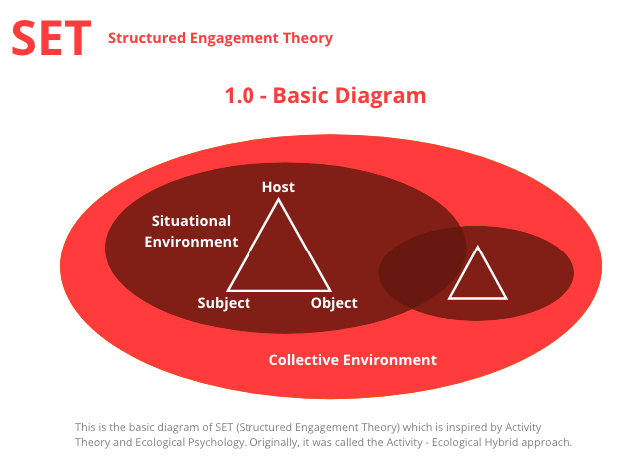
The SET Framework was originally named the Ecological—Activity Hybrid Approach. It was developed from 2017 to 2020 when I worked on several projects which refer to a new type of social action platform.
Traditionally, Activity Theory uses "Subject - Mediation - Object" as a basic unit of analysis. The Activity system model expands the basic unit of analysis to "Subject - Mediation - Object - Rules - Community - Divisions of Labour". However, I found there is a gap between Activity Theory and Intersubjective Social Design.
For example, I worked on a one-to-one video talk product from 2017 to 2018. Later, I worked on other projects which adopt Structured Engagement as a design pattern. These projects share the following aspects:
- Host: a special type of actors who host the whole activity.
- Structured Engagement: the activity is human-to-human interactions with a special structured process.
- Environment: the environment is also part of the design of the activity.
I started learning Activity Theory, Ecological Psychology, and other theories around 2015. Since then, I have often used some theoretical concepts such as Mediation from Activity Theory, Affordance from Ecological Psychology, etc for our product development discussions.
I realized the Activity System model, which is a popular theoretical framework of Activity theory, is not an ideal framework for theorizing above intersubjective social actions. In 2019, I developed the Ecological — Activity Hybrid Approach by adopting ideas from Activity Theory and Ecological Psychology. In 2020, I renamed the approach SET which stands for Structured Engagement Theory.
Originally, I used the notion of "Human as Mediation" to describe a new unit of analysis of "subject - host - object". Later, I directly used the term "Host" as a theoretical concept. In 2020, I expanded my views from the Activity System model to more theoretical resources. I found I can use other theoretical concepts of Activity Theory to replace my notion of “Human as Mediation.” During the process, I read more papers about Activity Theory and CHAT in general. For example, I found Cole’s “Joint artifact mediated action” and Vygotsky’s ZPD are close to my notion of “Human as Mediation.” By reading Cole’s book on cultural psychology, I found the connection between CHA and Ecological Psychology such as Roger Barker’s Behavior Settings.
I have read Behavior Settings for several years. Thus, I conceptualized the environment as a Double Environment. The primary environment is “Situational Environment” which is afforded by the Host while the secondary environment is “Social Environment” which is afforded by the platform and all users and activities. Eventually, I developed a general framework for social platform design.
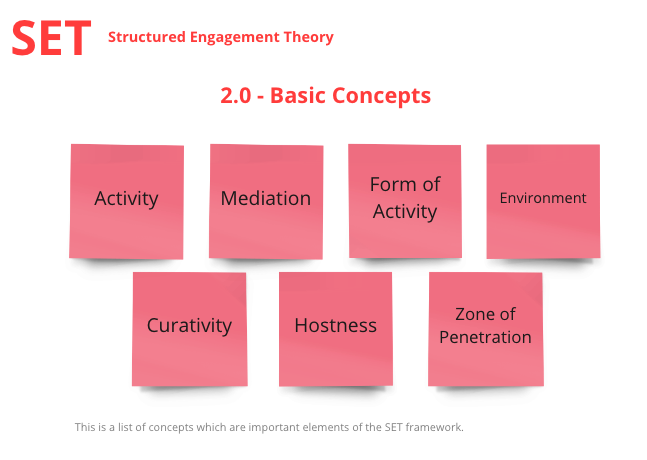
The SET framework adopts some theoretical concepts from Activity Theory. For example:
- Activity
- Mediation
It also adopts some concepts from Ecological Psychology. For example:
- Environment
- Zone of Penetration
I also developed several concepts for the framework in order to serve the needs of empirical research. For example:
- Forms of Activity
- Hostness
- Curativity
The name "SET" is inspired by Behavior Settings Theory which is one of the theoretical approaches of Ecological Psychology.
SET for Digital Platform Research
In 2021, I applied the SET framework to study digital whiteboard platforms such as Miro and Milanote. I designed an expanded diagram for my research. This expanded version has three types of environments:
- Situational Environment: For example, a Miro board and related events.
- Organizational Environment: For example, the team behind the Miro board.
- Technological Environment: For example, Miro and other related digital platforms.
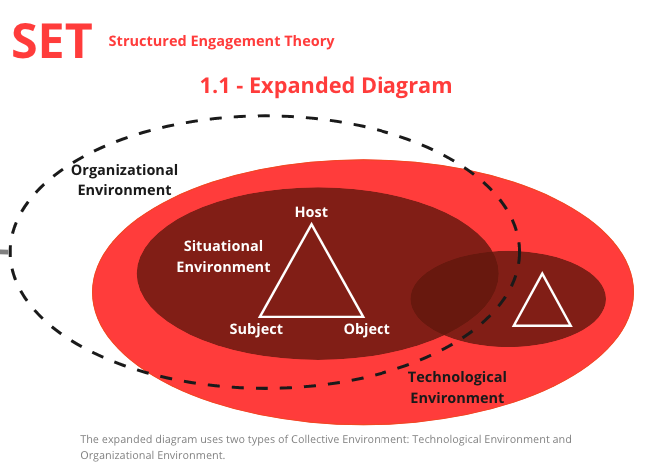
The concept of "Activity" is adopted from Activity Theory. In general, Activity Theorists understand "Activity" as a relationship between the Subject (an actor) and the Object (an entity objectively existing in the world) with Mediation (psychological tools and material tools).
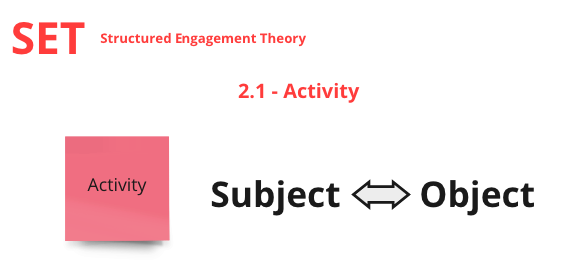
I defined a working concept called “Creative Work Communication Activity (CWCA)” for my research about Miro and other digital whiteboard platforms. For CWCA, the Subject is Team Members while the Object is Creative Solutions.
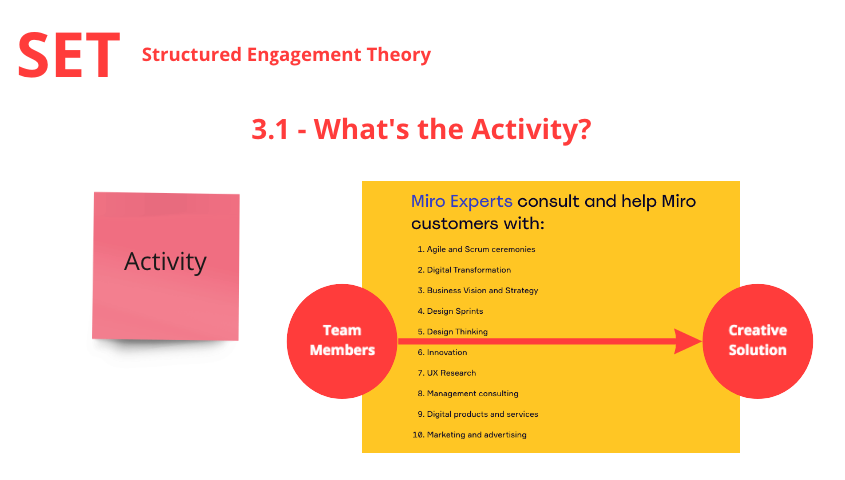
The concept of "Mediation" is the foundation of Leontiev's Activity Theory and its theoretical source: Vygotaky's Cultural-historical psychology. For Leontiev, his focus is Tools and Work Activities. For Vygotsky, his theory is about mediating actions and psychological development. In order to develop a framework for studying digital platforms, I return to Vygotsky's approach and consider both Tools and Signs as Mediations.
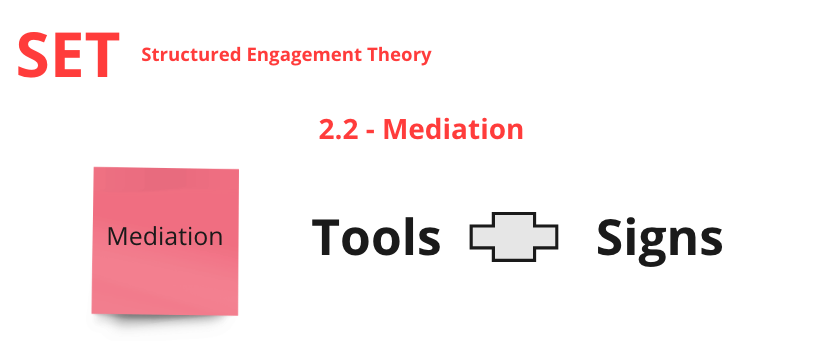
People use various thinking tools such as diagrams, frameworks, models, etc for CWCA. Miro uses “Templates” as a general name for these knowledge artifacts. From the perspective of Activity Theory, I consider these “Templates” as Mediation.
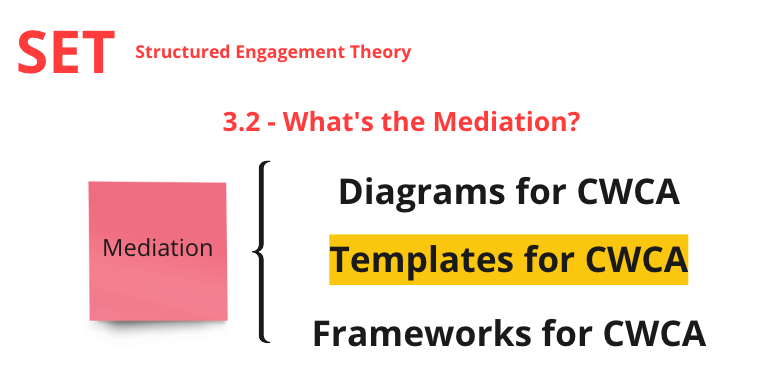
Activity Theorists don't use the term "Form of Activity". I personally use it for practical analysis. For example, the same Activity (a conference) can have three types Forms of Activity: Offline, Online, and Hybrid.
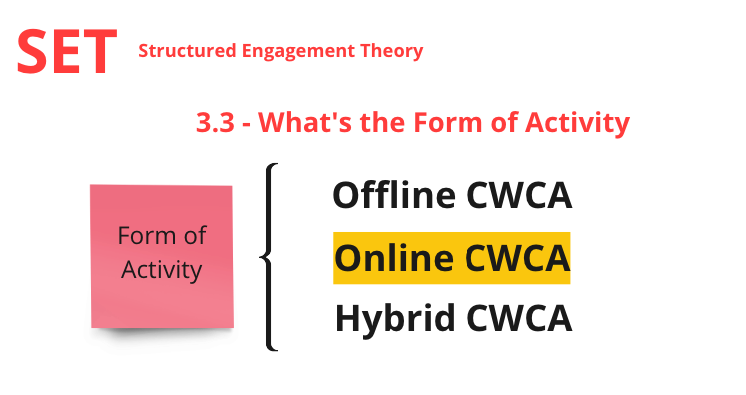
There are both three Forms of Activity for Creative Work Communication Activity (CWCA). The Miro platform can be used for these three Forms of Activity too. However, I only focus on one popular Form of Activity in 2021: Online CWCA.
Activity Theory doesn't have a concept of "Environment." I adopt the concept of "Environment" from Ecological Psychology. For the SET framework, I consider two types of environments:
- Situational Environment: it refers to the place where the intersubjective social actions happened.
- Collective Environment: it refers to the non-immediate social environments or large social environments
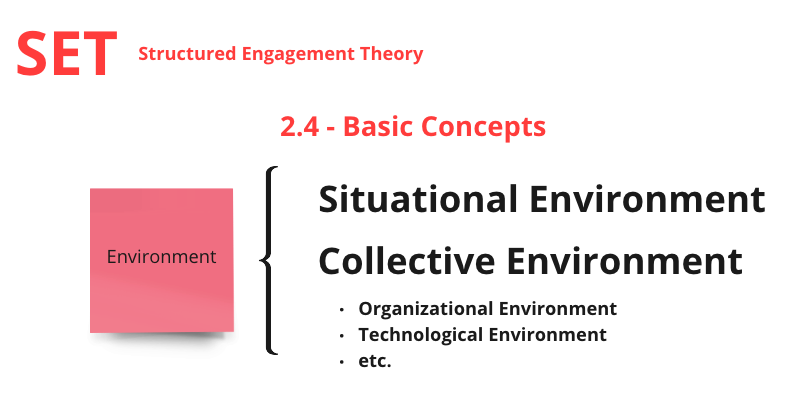
For studying CWCA, I use the following operational concepts:
- Situational Environment: the place where the Host meets the Subject. For example, a particular Miro board for a particular event.
- Technological Environment: the digital platform. For example, Miro.
- Organizational Environment: the team and the organization behind the Host.
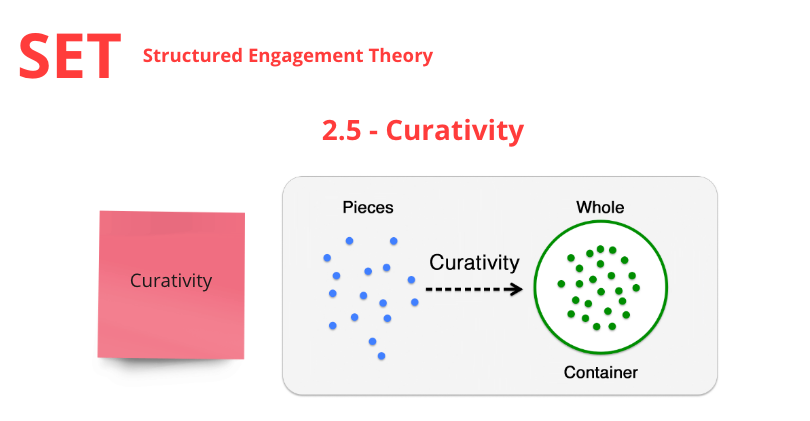
Activity Theory doesn't have a concept of 'Curativity." I coined the term in 2019 in order to develop a theory for discussing general curation practice. The term refers to "turning pieces into a meaningful whole." We can adopt the concept of "Curativity" for discussing:
- 1) the Curativity of Activity, and
- 2) the Curativity of Environment.
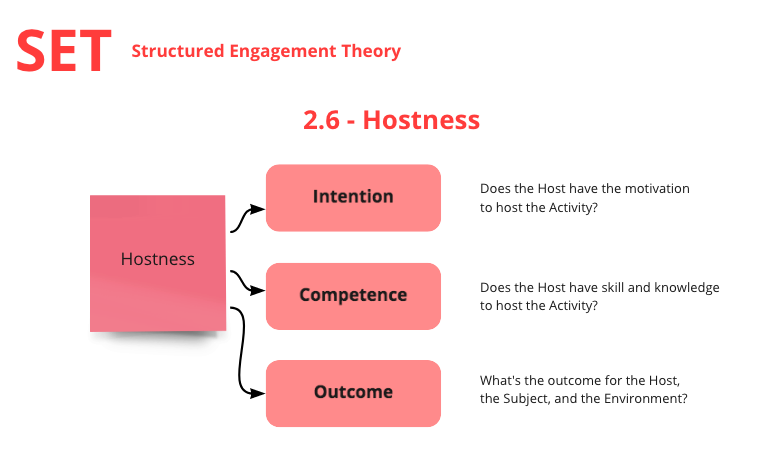
Activity Theory doesn't have terms such as "Host" and "Hostness." In 2019, I coined the term "Hostness" in order to develop the SET framework. The concept is developed as a three-dimension construct.
Zone of Penetration
I also adopted an important concept from Ecological Psychologist Roger Barker's Behavior Settings Theory.
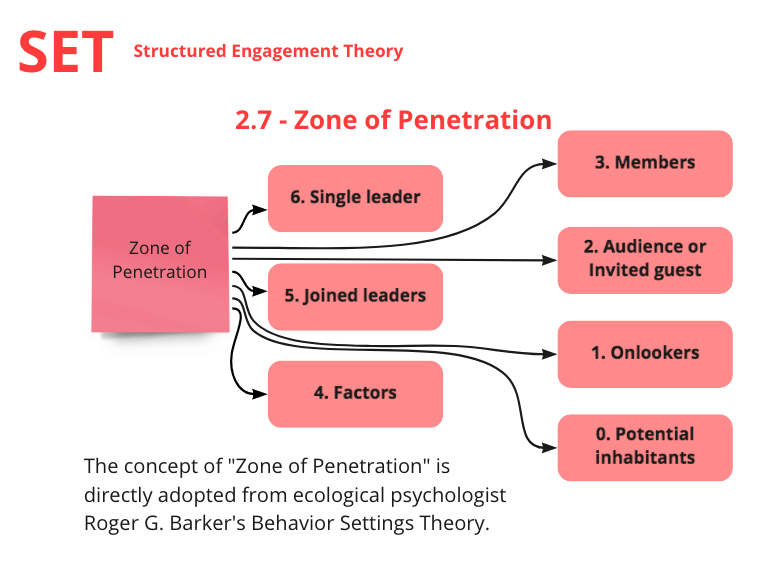
Barker developed a systematic analysis method for the Behavior Settings theory. One module of his method is “Zone of Penetration” which refers to the penetration dimension of Behavior Settings. He identified seven Zones of Penetration(1989, p.127–128).
- Zone 6: Single leader. Zone 6 is the most central zone. Included here are the positions of all persons who serve as single leaders of behavior settings. Persons in zone 6 have immediate authority over the whole setting during one or more regular occurrences of the settings.
- Zone 5: Joined Leaders. Persons who enter zone 5 lead the setting jointly with others in this zone during a single occurrence of a behavior setting. Persons in zone 5 have immediate authority over the whole setting, but their power is shared more or less simultaneously with others during one occurrence of the setting.
- Zone 4: Active functionary. Inhabitants of this zone have power over a part of a setting, but they do not lead it. The people in this zone have direct power over a limited part of the setting.
- Zone 6, 5, and 4: Operative or performers. Inhabitants penetrating to any of these zones are referred to as behavior setting operatives or performers.
- Zone 3: Member or customer. Occupants of zone 3 have great potential power but usually little immediate power. They are the voting members, the paying customers who ultimately make or break the setting.
- Zone 2: Audience or invited guest. The inhabitants of this zone have a definite place; they are welcome, but they have little power in the setting; at most they can applaud or express disapproval.
- Zone 1: Onlookers. This is the most peripheral zone within the setting. Persons in this zone take no active part in the standing pattern of behavior; at most they are onlookers. They are tolerated but not welcomed; they have no power within the setting.
- Zone 0: Potential inhabitants. Persons outside the setting itself but who occupy regions surrounding the setting are in zone 0; they are potential inhabitants.
The following table presents the attributes and nomenclature of the penetration zones of Behavior Settings. The term “Habitat-claims” refers to “Habitat-claims for human components” which are stable structural and dynamic features of the habitat provided by a community or an institution. The term “Implemented habitat-claims” refers to habitat-claims in operation. According to Barker, “Habitat-claims, human components, and implemented habitat-claims are all attributes of the habitat of the community or institution under study; they are whole-entity properties, created by the component behavior settings of the habitat (1989, pp.130–131)
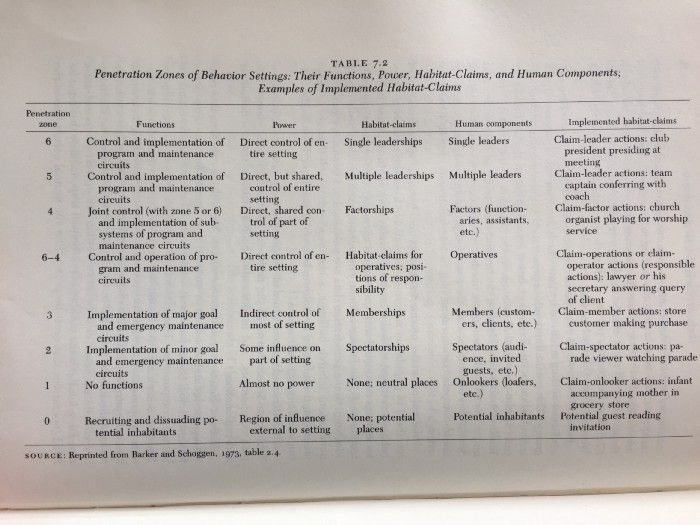
Though the SET framework doesn't adopt the whole approach of Behavior Settings Theory, I roughly use Zone of Penetration for discussing environments of SET.
SET for Developmental Service Design
I recently started to apply SET to discuss Developmental Service Design.
The notion of “Developmental Service” refers to a special type of service such as educational services, summer camps, adult life development programs, life discovery activities, etc. This notion refers to my own perspective of individual development.
In 2021, I used the SET framework to study Digital Whiteboard Platforms. I recently used the SET framework to study an adult developmental program. This change encourages me to think about the connection between Activity Theory and Service Design. See the diagram below.
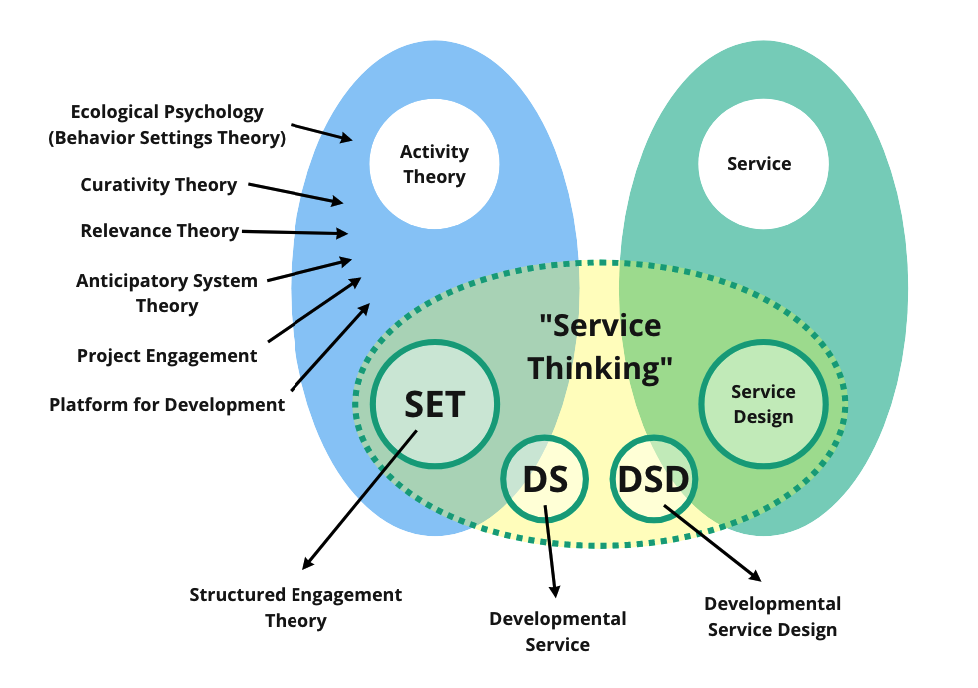
Finally, I found the notion of “Developmental Service Design” is a great connector.
- SET: Structured Engagement Theory
- DS: Developmental Service
- DSD: Developmental Service Design
- SD: Service Design
Since Developmental Service is a special type of service, Developmental Service Design is part of Service Design too.
According to Marc Stickdorn and Jakob Schneider who are the authors of This Is Service Design Thinking, “Service Design is an interdisciplinary approach that combines different methods and tools from various disciplines. It is a new way of thinking as opposed to a new stand-alone academic discipline. Service design is an evolving approach, this is particularly apparent in the fact that, as yet, there is no common definition or clearly articulated language of service design.”(2011, p.29)
In 2017, they published a new book titled This is Service Design Doing which is a practitioners’ handbook. They point out that “Service Design adopts the mindset and workflow of the Design Process, combining an active, iterative approach with a flexible and relatively light-weight set of tools borrowed from marketing, branding, user experience, and elsewhere. ”(2017, p.13)
The Service Design community shares a set of tools (such as Journey Mapping, Prototyping tools, Business Model Canvas, etc) with other communities such as Lean Startup community, Design Thinking community, etc.
Developmental Service Design could adopt the mindset and workflow of the Design Process and tools from the Service Design community, it also could expand its toolkits from Developmental Service Study.
This is the amazing engagement between Theory and Practice. Each dialogue always leads to a new creative space.
